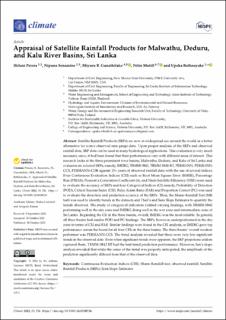| dc.description.abstract | Satellite Rainfall Products (SRPs) are now in widespread use around the world as a better alternative for scarce observed rain gauge data. Upon proper analysis of the SRPs and observed rainfall data, SRP data can be used in many hydrological applications. This evaluation is very much necessary since, it had been found that their performances vary with different areas of interest. This research looks at the three prominent river basins; Malwathu, Deduru, and Kalu of Sri Lanka and evaluates six selected SRPs, namely, IMERG, TRMM 3B42, TRMM 3B42-RT, PERSIANN, PERSIANN-CCS, PERSIANN-CDR against 15+ years of observed rainfall data with the use of several indices. Four Continuous Evaluation Indices (CEI) such as Root Mean Square Error (RMSE), Percentage Bias (PBIAS), Pearson’s Correlation Coefficient (r), and Nash Sutcliffe Efficiency (NSE) were used to evaluate the accuracy of SRPs and four Categorical Indices (CI) namely, Probability of Detection (POD), Critical Success Index (CSI), False Alarm Ratio (FAR) and Proportion Correct (PC) was used to evaluate the detection and prediction accuracy of the SRPs. Then, the Mann–Kendall Test (MK test) was used to identify trends in the datasets and Theil’s and Sens Slope Estimator to quantify the trends observed. The study of categorical indicators yielded varying findings, with TRMM-3B42 performing well in the dry zone and IMERG doing well in the wet zone and intermediate zone of Sri Lanka. Regarding the CIs in the three basins, overall, IMERG was the most reliable. In general, all three basins had similar POD and PC findings. The SRPs, however, underperformed in the dry zone in terms of CSI and FAR. Similar findings were found in the CEI analysis, as IMERG gave top performance across the board for all four CEIs in the three basins. The three basins’ overall weakest performer was PERSIANN-CCS. The trend analysis revealed that there were very few significant trends in the observed data. Even when significant trends were apparent, the SRP projections seldom captured them. TRMM-3B42 RT had the best trend prediction performance. However, Sen’s slope analysis revealed that while the sense of the trend was properly anticipated, the amplitude of the prediction significantly differed from that of the observed data. | en_US |

